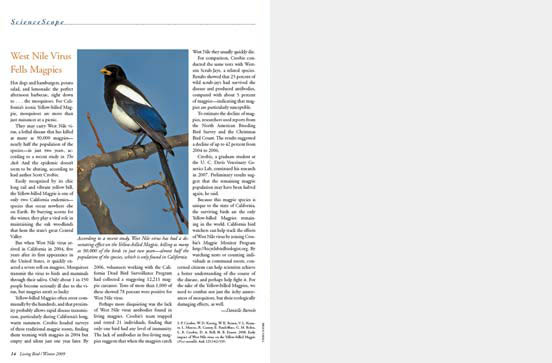West Nile Virus Fells Magpies
By Danielle Bartolo January 15, 2009
Hot dogs and hamburgers, potato salad, and lemonade: the perfect afternoon barbecue, right down to . . . the mosquitoes. For California’s iconic Yellow-billed Magpie, mosquitoes are more than just nuisances at a picnic.
They may carry West Nile virus, a lethal disease that has killed as many as 90,000 magpies—nearly half the population of the species—in just two years, according to a recent study in The Auk. And the epidemic doesn’t seem to be abating, according to lead author Scott Crosbie.
Easily recognized by its chic long tail and vibrant yellow bill, the Yellow-billed Magpie is one of only two California endemics—species that occur nowhere else on Earth. By burying acorns for the winter, they play a vital role in maintaining the oak woodlands that hem the state’s great Central Valley.
But when West Nile virus arrived in California in 2004, five years after its first appearance in the United States, it quickly exacted a severe toll on magpies. Mosquitoes transmit the virus to birds and mammals through their saliva. Only about 1 in 150 people become seriously ill due to the virus, but magpies aren’t so lucky.
Yellow-billed Magpies often roost communally by the hundreds, and that proximity probably allows rapid disease transmission, particularly during California’s long, warm summers. Crosbie headed surveys of three traditional magpie roosts, finding them teeming with magpies in 2004 but empty and silent just one year later. By 2006, volunteers working with the California Dead Bird Surveillance Program had collected a staggering 12,211 magpie carcasses. Tests of more than 1,000 of these showed 78 percent were positive for West Nile virus.
Perhaps more disquieting was the lack of West Nile virus antibodies found in living magpies. Crosbie’s team trapped and tested 21 individuals, finding that only one bird had any level of immunity. The lack of antibodies in free-living magpies suggests that when the magpies catch West Nile they usually quickly die.
For comparison, Crosbie conducted the same tests with Western Scrub-Jays, a related species. Results showed that 25 percent of wild scrub-jays had survived the disease and produced antibodies, compared with about 5 percent of magpies—indicating that magpies are particularly susceptible.
To estimate the decline of magpies, researchers used reports from the North American Breeding Bird Survey and the Christmas Bird Count. The results suggested a decline of up to 42 percent from 2004 to 2006.
Crosbie, a graduate student at the U. C. Davis Veterinary Genetics Lab, continued his research in 2007. Preliminary results suggest that the remaining magpie population may have been halved again, he said.
Because this magpie species is unique to the state of California, the surviving birds are the only Yellow-billed Magpies remaining in the world. California bird watchers can help track the effects of West Nile virus by joining Crosbie’s Magpie Monitor Program. By watching nests or counting individuals at communal roosts, concerned citizens can help scientists achieve a better understanding of the course of the disease, and perhaps help fight it. For the sake of the Yellow-billed Magpies, we need to combat not just the itchy annoyances of mosquitoes, but their ecologically damaging effects, as well.
S. P. Crosbie, W. D. Koenig, W. K. Reisen, V. L. Kramer, L. Marcus, R. Carney, E. Pandolfino, G. M. Bolen, L. R. Crosbie, D. A. Bell, H. B. Ernest. 2008. Early impact of West Nile virus on the Yellow-billed Magpie (Pica nuttalli). Auk 125:542–550.

All About Birds
is a free resource
Available for everyone,
funded by donors like you
American Kestrel by Blair Dudeck / Macaulay Library



